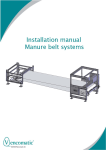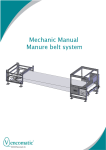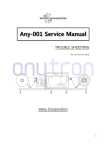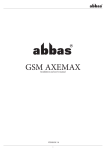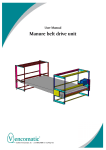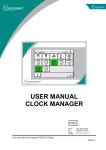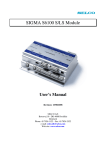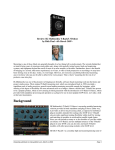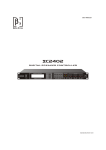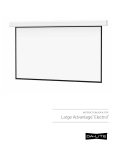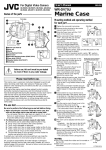Download Mechanic Manual Driveunit D
Transcript
Mechanic manual Manure Belt System. First of all, the mechanic must be fully informed about the User Manual. Installation: 1. Check the delivered drive and return units. a. The drive unit (fig A): Are all parts mounted? Can you move the bearing plates (no 8 fig A) freely, is there enough clearance on the lock nuts? (n° 6+7 fig A) Can you move the side plate at the none motor side and is the motor side blocked? b. The return station (fig B): Are all parts mounted? Will the cage roller (n°1 fig B) remove the dirt when you rotate it in the right direction? If not, turn the cage roller. 2. Welding the belts, adjusting the Return Unit (R.U) and the Tension Unit (T.A.) in the Drive Unit (D.U.) a. Welding a belt. Take care! When you weld a belt, keep the cage roller roughly in the middle of the adjusting range.( fig B) Otherwise there is no space any more for the small scrapers (n° 2 fig B) that are in front of the cage roller. Take care, it is dependant on the temperature and the length of the house. Remind that a belt will shrink when it is getting colder in the house. Don’t forget to mount the small belt plates (art.n°. 276185 of 3000200621) and bend them a little by hand. This will prevent cutting the belt. b. The welding: When you looped the belt through the T.U. and the D.U. hold it tight. Take care! The position of the cage roller must be roughly in the middle of the adjusting range. The springs in the T.U. are not stretched now. Keep the piece of the belt, which comes out of the section, below . Remove the sharp edges so nothing can hook when the belt is running. Put the other piece over the “section part” and overlap 3 yards. Keep both parts aligned. This is very important. Keep the joint above the turning plate. (n° 2 fig A) You can weld here with a sonic welder without using a special piece of sheet metal. Attach both parts with a few welds. Keep the overlap 3 inches at the 78 “and 90” units. At 45 and 67 units 2.5 inch is enough. When it is welded, cut the overabundance . Imported things; Keep both parts aligned. The temperature of the house and belts must be 59 ° F or more. So, don’t store the belts outside. After welding don’t run the belts for 4 to 6 hours. The welds must crystallize. (supplier’s advice) c. Adjusting the R.U. (preload of the belt) How tight must the belt be adjusted? Often they are too tight. Remember this is not a conveyor belt. A new belt (not running and without manure) is adjusted when the tension roller (n° 10 fig A) in the T.U is somewhere in the middle of the slot. ( fig. 2 and 3) When the belt runs for the first time it will stretch a little. After this first run the tension must be checked. (and adjusted, if necessary) fig 1 d. Check the adjustment of the T.U. The scraper on the tension roller is already adjusted in the factory, but please check this. Also check the tension of the springs, they must be the same on both sides. See the screw eyes. fig2 fig3 3. The turning plate (n° 2 fig A). The turning plate has a double function. a. First: Preventing that a loop in the belt (n° 11 fig A) gets stuck between the belt itself and the drive roller. (n° 3 fig A). The T.U. should prevent this but when the belt is not adjusted in a proper way this is an extra safety. b. Second: On the ends of this part are two, stainless steel scrapers. These parts keep the drive roller clean. They prevent that manure what, in spite of the two plastic guiding plates, (nr 12 fig A) comes between the belt and the drive roller can built up on the drive roller. When this occurs the diameter of the drive roller will increase and the scraper (n° 4 fig A) will not clean the belt completely. Only the both ends of the belt will be clean and the important middle part will stay dirty. The rubber cams on the pressure roller (n° 1 fig A) will loose all traction and the belt will not run anymore. This is a common failure, so pay attention. c. Adjusting the turning plate after welding the belts. The two stainless steel scrapers must not touch the drive roller, this will generate a horrible, squeaking sound when you run the belt and it will scare the birds. Always keep a small gap between the scrapers and the drive roller. 4. Adjusting the pressure roller and middle pressure point(n° 13 fig A). a. The function of the pressure roller is to press the belt against the drive roller and, even more important, to pull the belt firmly around the drive roller. That’s why the circumference speed is 4% more. This also helps to steer the belt. (The rubber cams are not at the ends of the roller so the drive roller will act like conical pulleys) b. If this pressure roller is dirty ( wet manure) it’s function is bad, the traction is lost and the belt will stall, therefore it is very important to keep this roller and its cams clean. Small scrapers (n° 5 fig A) keep the cams clean. After running the belt this should be checked and cleaned. c. Adjusting the pressure: The pressure is adjustable through the red springs. The tension must be the same at both ends so it is best to build up the pressure evenly, so step by step. When you tighten first one side and than the other side the risk of an outbalance pressure roller is very high. Always check the gap between the bearing plates and the side plates. (In the latest models small center points are punched in.) d. The middle pressure point (n° 13 fig A) (when delivered) is already adjusted in the factory but can be changed if necessary. When adjusting or re-adjusting this device, always be sure that the pressure of the pressure roller is even on both ends and the position is, as described in 4c 5. Adjusting the pressure roller scrapers (n°5 fig A): a. As close as possible but they must never touch the rubber cams, spatial the older, glued types with a profile . b. Later models have a different device with springs, no adjustment needed. 6. Don’t forget to adjust the drive chain. Explanation the customer / user: Start to make clear that the Manure belt drive system is not a conveyor belt and should not be treated like one. A conveyor belt is often equipped with a rubber belt and this will act like a big rubber band. A conveyor belt always has a high preload. When this conveyor belt stalls, the preload must be increased at the return side. The traction will be more and the belt will run again. This is the big difference with a manure belt drive system. The PP belt is not rubber but acts more like a sheet metal plate. The preload is as less as possible, just enough to cope with the stretch when running the belt. When the belt stalls, increasing the preload will work in contrary. The cage roller and the rollers in the T.U. will bend (and probably damage) and the resistance will increase. The forces on the belt will be tremendous. Since the force on the belt is in particular on the middle part of the belt, (where the rubber cams are mounted) the material in the middle part will be overstretched. At both ends this will not appear so the belt deforms and the only way the stretched material can go is upwards. If you overstretch the belt even more, the belt will run double in the middle and you lost a belt, because the deformation will last forever. Always show the User Manual to the customer/user while explaining. In this User Manual steering, tensioning and maintenance are clear described but explain him again that he can only move the side where no motor is mounted. The motor side is blocked. (In case of an emergency Vencomatic personnel can remove this blockage and steer on this side. Always check the tension of the drive chain when you do this) Tell the customer/ user that in particular when steering the belt a side plate will move towards him when he tightens the nut, but will not go backwards when he loosens the nut. When he runs the belt, after adjusting, the side plate will move backwards most of the time (because of the force on the belt) but not always. Sometimes he must help it with a crowbar or something like that. What he must do when a belt stalls (and what certainly not): When a belt stalls never increase the preload. When the belt ran okay before, first check why it stalls now. Possible causes: • Too much manure on the belt. Too much weight. Too wet because of a leaking drinking system, poor ventilation in colder seasons. It is also possible the manure rises too high, against the slat bars. The resistance will be very high. • The rods, under the return part of the belt, are serious polluted. Dried manure is built up and the belt gets stuck between the dry manure and the tubes (between the two parts of the belt). This happens often when the scrapers are not cleaned and the belt is dirty. • One or both rollers in the T.U. is damaged or is oblique . • The cage roller is damaged or will not rotate anymore. Check why!! • Are the keys mounted in the keyways from the plastic sprockets??? • Temperature dropped (cleaning the house) and somebody forgot to decrease the tension of the belt • Poor ventilation, the manure is heavier because of the moister. • The scraper does not clean the belt. • Another cause, something is braking the belt. When you checked everything and did not find a cause, you may increase the tension of the pressure roller. (the red springs) Remind, keep the tension on both sides even. When a middle pressure point is installed you may increase the pressure a little. Never increase the pressures more than necessary. Tell the user again to decrease the tension at the R.U. when the birds go out of the house and the belts will shrink. They often forget this. Anthony Bal Mechanical Engineer Vencomatic, The Netherlands ©2008 Vencomatic b.v. Short Checklist Drive Unit Manure Belts. Remark: This is just a short checklist. For more information, read the manual. Starting the drive units: 1. Safety first. Does everybody knows you want to start the drive units and cross conveyor(s) 2. Tension the scrapers (are they clean??) 3. Run the belts and….. 4. Check the distance left and right. If adjusting is needed only adjust the side where no moter is mounted. (because of the tension of the chaine) Adjusting always when the drive unit is not running. One half turn at the time. 5. Check the position of the belt tension unit (tensionroller should be in the middle of the groove) 6. Keep looking at the belts all times. A damaged belt can cause problems with the scrapers. 7. Check the return stations. (are the belts in the middle) After running the belts: 1. Safety first. Start cleaning when all systems are shut down. 2. Release the scrapers and keep them released. 3. Clean the scrapers, in particular the back side of the pur strip. 4. Clean the rest of the unit (don’t forget the pressure rollers) 5. Check and clean the return stations. Don’t forget when the house is going empty Always take care that at the moment the chickens are out of the house, the return stations of all manure belt systems and also the return stations of the egg-belt has to be put back in the lowest tension positioning. When the birds are going out of the house, the temperature will drop and the belts will shrink. If you don’t release the return-stations to get off all tension of the belts, a lot of damage can be done on the belt itself, cage-rollers etc.. because the basic-material PP react enormous on temperature. As example, 10° C / 18° F. lower / reducing in a house of 100 mtr. / 109 yd. length will give a shrinkage of 35 cm./ 1 ft. of the belt.











